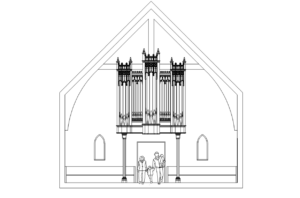
We are exhilarated to announce the fulfilling of Dr. Harold Andrews’s vision in the completion of our organ with the addition of an Antiphonal division.
The original design and Dr. Andrews’s desire
The design of our Casavant organ in the mid-1980s included divisions of the organ in two locations. The decision was made that the division for the rear wall would be left for a later building project. Dr. Andrews worked for thirty-plus years to see it realized. That time has come and we are thrilled at the possibilities it will bring.
What is an Antiphonal?
This division, known as an Antiphonal, is a compartment of the organ that will speak directly on the axis of the nave. It will be situated over the narthex and enter the nave over the double-door entrance.
Why is it important?
Its purpose is to aid in leading hymns and service music by supporting the congregation with a broad foundation tone, emphasizing stops that play at human singing level with timbres that invite participation rather than coerce by high pitches and loudness.
Won’t it be too loud?
Our current configuration mandates a front division that must utilize aggressive tone in order to lead singing, all the while sharply falling off at about a third the way back. Such aggressive tone also challenges the organ’s ability to accompany anthems and psalms.
Capabilities of the organ
The presence of the antiphonal will mean that the front can be softened. Such modification parallels the new division’s emphasis on broad, supportive tone. Yes, the room will be filled with sound, but it should ultimately feel less piercing than current. Further, it will mean that the organ can more artistically accompany the choir and capitalize on what is a characteristically Anglican organ timbre. Our initial communication with the builders made our priorities clear: firstly, to best support congregational sound, secondly, to accompany the choir with finesse, and then to convincingly play broad-based organ repertoire.
What will it look like?
Will it aesthetically complement the church?
Will it change in front?
We have taken seriously the aesthetic appeal of the Antiphonal’s case. We communicated with the builders our desire to make minimal impact on the worship environment. Goulding & Wood returned with a design that echoes the motifs from our beautiful Altar reredos. The concept at hand is a case that should appear as though it were original to the building, ninety-five years ago. There will be no change to the appearance in the chancel, including the console and its placement.
Will it feel like walking into the mouth of an organ?
The overhang into the nave is around thirty inches, and it will begin around ten feet from the floor. While it won’t be invisible, it will not overpower the rear wall nor feel like one is being swallowed by it.
Refurbishing the existing organ for long-term care
In re-scaling and re-voicing the pipes we have, they will be lovingly restored. Each of over 1,600 pipes will be cleaned and, if needed, repaired, leather will be replaced, and valves will be cleaned. The “brain” of the organ will be upgraded to a solid state system. The end result of the process will provide us with an instrument that will defy its forty years and should prevent expensive maintenance for decades to come.
How is it being funded? Is this what I pledged to?
Some of the expense for the project will come from the funds Dr. Andrews raised over the years, but ninety-nine percent will be funded by an anonymous donor. The timing with our wonderful campaign for a music endowment is a happy coincidence, but the two projects are completely unrelated. NO money pledged to the music endowment will be used for this. The costs for the Antiphonal project are being borne by the generosity of the donor.
How was it chosen?
The Goulding & Wood firm of Indianapolis is a leader among American organ builders in providing Episcopal churches with instruments that reflect our particular musical heritage. You will find a list of their instruments below. Mark Goulding wrote to us,
After careful consideration of the liturgical needs of your congregation and the specific acoustical properties of your church, we have designed an instrument that we feel will provide exciting leadership for worship. This design is comprehensive and encompasses complete, musical resources, reliable mechanics and an aesthetically pleasing visual presence. Building an instrument that neglects any one of these areas yields an installation unable to satisfy the exacting demands of corporate worship or to endure for many years. By excelling in each of these areas, Goulding & Wood, Inc. builds pipe organs that are equipped to enrich the life of your congregation for many generations to come.
We solicited four builders who claim specialty in designing instruments for Anglican worship, three of whom supplied intriguing proposals. After meeting with the builders and traveling and listening to other organs they built, we came to the conclusion that Goulding & Wood will supply an instrument that honors our heritage, both as St. Marians and Anglicans.
What will we do while the organ is gone?
While it is being refurbished and the Antiphonal portion built, there will be a period of eight to ten months when we will be without our organ. We are investigating different options for that interim time, including using the piano, the chapel organ, and short term acquisition of a digital instrument. For festival occasions, we will incorporate strings or brass. We will maintain our best quality while also being considerate of cost effective measures. That time frame is expected to be late-Spring 2025 for installation before Easter 2026.
Please be in contact with any questions or concerns.
Please, please—If you have any questions or concerns, do ask the Organist & Choirmaster, or the Rector, or a member of the advisory committee. This is an overwhelmingly positive moment for St. Mary’s, and we are open-eared for any concerns you might have.
Charles Hogan, The Rev’d Rob Travis, Steve Bingham, Beth Penley, John Wall, George White
ABOUT THE BUILDER
Goulding & Wood, Inc. is one of the nation’s leading organbuilders, focusing on the needs of worshiping congregations through the installation of highly refined musical instruments. The company was incorporated in 1980 as a collaboration between John Goulding and Thomas Wood. At the time of incorporation, Mr. Goulding had more than twenty-five years of experience as an organbuilder, including tenures with the firms of Gratian Organ Company and Holtkamp Organ Company as well as several years as a partner in the firm of E. H. Holloway Corporation. Mr. Wood brought a background including electrical engineering training and organ study. Prior to joining forces with John Goulding, Mr. Wood headed the electronic music laboratory of Indiana University, served as pipe organ curator for the university and led several restoration projects under his own name.
Since its beginning, Goulding & Wood has confirmed its reputation as one of America’s premier organ builders. Throughout this time, the versatility of the shop has continued to grow, as evidenced by the broad spectrum of casework styles and scope of instrument sizes. In addition to APOBA, Goulding & Wood is a member of the International Society of Organbuilders. Several members of our team have held leadership positions in Associated Pipe Organ Builders of America, the American Institute of Organbuilders, and the American Guild of Organists.
Now in its second generation, Goulding & Wood continues to grow and expand, building instruments that enrich worship of congregations across denominational lines. We design organs specifically to meet the liturgical needs of the contemporary church as well as to follow historical precedents. The resulting instruments lead congregations with authority and render the rich repertoire of organ literature with fidelity and conviction.
Tonal philosophy
Goulding & Wood instruments are characterized by balance and sophistication in the tonal design and voicing. We strive to cultivate a maximum amount of color and variety while maintaining a tight, cohesive ensemble. Believing that congregational singing is the foundational concern of the organ, we build instruments with generous fundamental development to clearly delineate pitch. Multiple stops at 8′ pitch, broad scaling and clean, incisive voicing combine to serve as a strong base of the organ’s sound. Judicious use of upperwork completes the chorus, adding to the coloristic possibilities, while the power of the sound is always driven at the 16′ and 8′ range. Mixtures supply brilliance without ever becoming overstated or overpowering. In all, the objective is a gentle, pleasing sound that envelops the audience or congregation.
By designing and voicing each instrument individually, we can ensure that the finished product will work within its unique situation. The musical personality of the congregation dictates how the design is built. A delicate balance is struck between the immediate needs of the musicians present, incorporating their vision for the ongoing development of the music program, and overarching needs of the congregation in a larger context. A comprehensive design must be larger than any one person, thus we listen carefully to the desires of the present musicians while bringing these ideas into parity with broader design principles.
Aesthetics of casework
Pipe organs incorporate extensive mechanical resources, and it is essential that they be as musically conceived and carefully built as the pipework that they support. Complementing our primary focus of supporting worshiping congregations, our mechanical resources provide reliable, sustainable support that encourages the style of voicing we employ.
Goulding & Wood organs participate actively in the liturgical and aesthetic properties of the church through their visual presence in the room. Once thought superfluous or even injurious to the sound of the instrument, cases are much more than decorative add-ons; rather, the encasing of the organ focuses the sound while the round bodies of the display pipes blend the sound of individual pipes into a unified sonorous voice. By the same token, the architecture of the room benefits from a collaboration with the organ as one of the largest elements. Design approaches can begin from a premise of the organ as a piece of furniture set in the room or a premise of the organ as a member of the architectural structure. Similarly, cases can either feature existing decorative elements, bringing the instrument into cohesion with the room, or they can tastefully stand apart from the room, enriching the stylistic range present. With either approach, our case designers pay special attention to having the organ operate in close dialogue with the room, particularly in dictating the proportions of the display.
Both consoles and cases are essential elements to the organ’s design, and they provide another avenue to support the musical and liturgical needs of the congregation the organ serves.
